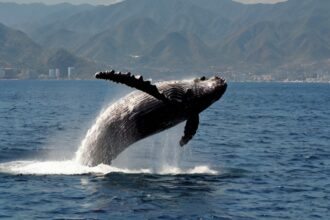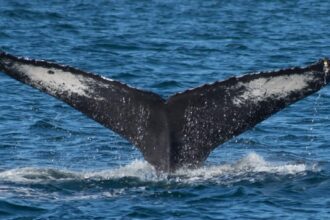Humpback Whales
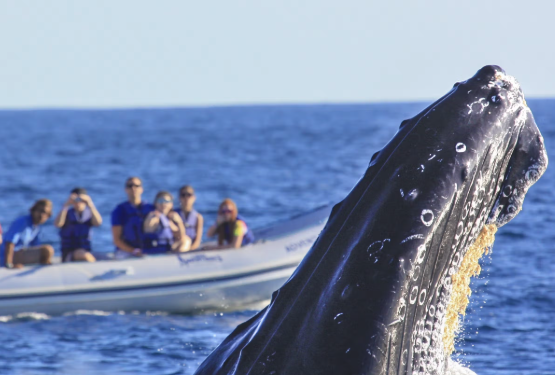
Humpback whales are nature’s most remarkable musicians. They create complex songs that can last up to 20 minutes. Their haunting vocalizations span multiple octaves and include frequencies beyond what human ears can detect, making them one of the most fascinating phenomena in the animal kingdom.
These marine maestros weigh up to 40 tons and reach lengths of 60 feet. They perform a fascinating annual ritual where all males in a population sing the same evolving song throughout the breeding season. Their unique vocal abilities have made them popular with whale-watching operations worldwide, giving people chances to witness spectacular surface behaviors like breaching and tail slapping firsthand.
Let’s explore the intricate world of humpback whale songs, from their complex structure to their vital role in communication and social bonding. These magnificent creatures use their voices during their impressive 5,000-mile migrations. Understanding their songs plays a significant role in their conservation efforts.
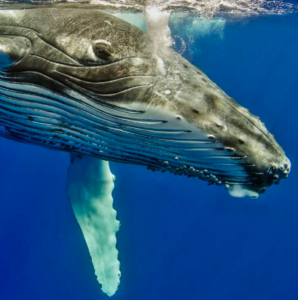
Table of Contents
- 1 The Incredible Anatomy of a Humpback’s Song
- 2 Masters of Musical Migration: Songs Across Oceans
- 3 The Science Behind Whale Song Research
- 4 Beyond Mating: Multiple Purposes of Whale Songs
- 5 Conservation and the Future of Whale Songs
- 6 Here are some FAQs about the humpback whales:
- 6.1 When can you see humpback whales in Puerto Vallarta?
- 6.2 Why do humpback whales come to Puerto Vallarta?
- 6.3 What kind of whales are in Puerto Vallarta right now?
- 6.4 Is Puerto Vallarta good for whale watching?
- 6.5 What time of day are humpback whales most active?
- 6.6 Are there killer whales in Puerto Vallarta?
- 6.7 Are there sharks in the ocean in Puerto Vallarta?
- 6.8 Are there crocodiles in the ocean in Puerto Vallarta?
- 6.9 What animal is Puerto Vallarta known for?
The Incredible Anatomy of a Humpback’s Song
Humpback whale songs showcase a masterpiece of natural acoustics through their intricate architecture. Male humpbacks create their songs using a fascinating hierarchical structure that marine biologists have decoded. Their songs follow a precise pattern where individual sounds, called units, combine to form larger musical elements:
- Single units (lasting 2-3 seconds)
- Phrases (combining 4-6 units, spanning 15 seconds)
- Themes (repeated phrases lasting 2-4 minutes)
- Complete songs (multiple themes, extending to 30 minutes)
Scientists have uncovered the remarkable mechanism behind these haunting melodies. Humpbacks have a specialized U-shaped structure in their larynx with a unique fatty cushion, unlike other mammals. The fatty pad vibrates against the vocal cords when air passes through this distinctive anatomy, which produces their signature sounds. This extraordinary adaptation lets these marine mammals create and recycle sounds underwater without risking water inhalation.
The acoustic range of humpback whales goes well beyond what human ears can detect. Their vocalizations range from deep, resonant bass notes at 20 Hz to surprisingly high frequencies reaching beyond 24,000 Hz. These songs travel impressive distances underwater, and some low-frequency sounds can reach up to 10,000 miles in certain ocean conditions.
These aquatic concerts pack quite a punch in volume. Individual song units can hit 173 decibels, though not all parts of the song are equally loud. The longer, broadband units that sound like rumbles and grunts typically produce the highest volumes. The more tonal elements tend to be quieter.
The songs keep changing, with all males in a population singing the same version at any given time. During whale watching excursions, you might witness what scientists call “song evolution” – where the entire male population gradually changes their song throughout the breeding season. These new variations spread through the community.
This complex vocal system does more than just create beautiful sounds. The songs help maintain acoustic contact during migration, though we see them most often during breeding behavior. The precise structure and ongoing changes in these songs show a level of vocal sophistication that continues to amaze marine researchers and whale enthusiasts alike.
Masters of Musical Migration: Songs Across Oceans
Male humpback whales arrange an extraordinary musical experience that spans thousands of miles across the vast ocean. These marine musicians change their songs as they travel between summer feeding grounds and winter breeding areas. They cover impressive distances of up to 10,000 kilometers in their annual migrations.
How songs vary during humpback whale migration
Male humpbacks show remarkable vocal flexibility throughout their migratory cycles. Scientists once thought these cetaceans sang only in breeding grounds. They later found that whales vocalize throughout their journeys. The singing patterns reach their peak during winter months, especially from December to May. January, March, and early April show the highest activity.
Regional differences in song patterns
Each ocean region creates its own population-specific melodies, which leads to distinct musical dialects. The North Pacific’s separate populations maintain their unique vocal signatures:
- Hawaiian populations develop distinctive themes
- Mexican coastal groups craft region-specific patterns
- Japanese and Philippine groups maintain local variations
Geographic isolation shapes these differences, and each breeding population keeps its distinctive song pattern. The sort of thing I love is how these regional variations stay intact despite whales moving extensively across ocean basins.
Cultural transmission between populations
Nature shows one of its most sophisticated examples of cultural learning through song transmission between populations. Songs move eastward across the Pacific Ocean from Australia to French Polynesia and continue to Ecuador – a remarkable distance of over 14,000 kilometers. This cultural exchange allows whales from different regions to learn and adopt new songs with impressive accuracy.
South Pacific whale populations share and modify their musical repertoires in a unique pattern. Whales in New Caledonia can learn complex songs from their Australian counterparts without simplifying the patterns. These learned melodies progress gradually as they travel across ocean basins. Each population adds its subtle modifications.
This cultural transmission happens through three main channels: shared feeding grounds, migratory route encounters, and occasional movement between populations. Scientists found “whale karaoke parlors” – specific locations where different populations join to share and learn new songs.
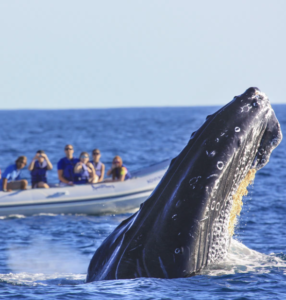
The Science Behind Whale Song Research
Scientists have found sophisticated ways to decode the mysterious songs of humpback whales. Advanced underwater recording systems now give us fascinating insights into these ocean giants.
Methods for recording and studying whale songs
Marine researchers use specialized underwater microphones called hydrophones to capture these aquatic melodies. The original recording systems had arrays of five hydrophones placed 35 meters deep and spaced 7 meters apart. This setup helps scientists track singing whales with remarkable precision and determine their distance and depth.
Key discoveries about song complexity
Research has revealed remarkable findings about song structure and patterns. Individual song units can reach impressive volumes between 151 and 173 dB. The research team found that longer, broadband units that produce rumbles and grunts generate the highest volumes. Tonal elements tend to be quieter in comparison.
New studies show that humpback whales can hear frequencies beyond 24 kHz. This is a big deal as it means that their hearing abilities exceed previous estimates. The research highlights several key findings:
- Songs maintain consistent patterns across populations
- Males can learn all but one of these songs within a single season
- Song complexity increases through gradual development
- Complete song replacement occurs during revolution events
Modern technology in whale song research
Artificial intelligence and machine learning have reshaped whale song analysis. Scientists exploit deep learning convolutional neural networks to process over 187,000 hours of acoustic data from 13 different monitoring sites. This technology allows researchers to analyze massive datasets within hours instead of the years needed with traditional methods.
Modern passive acoustic monitoring systems, like Marine Autonomous Recording Units (MARUs), track whale movements and behaviors throughout the year. These “pop-up” buoys collect extensive acoustic data. The retrieved data provides valuable insights into whale population dynamics and migration patterns.
Cloud computing has accelerated research capabilities even further. The NOAA Big Data Program processes terabyte-scale audio data in parallel. This makes it possible to study whale songs across big ocean regions efficiently. These technological advances have created new opportunities to understand these magnificent marine mammals and their complex vocal behaviors.
Beyond Mating: Multiple Purposes of Whale Songs
Recent findings show that humpback whales use their voices for much more than just courtship. These amazing creatures communicate in ways that highlight their social smarts and survival skills.
Communication between mother and calf
A mother humpback’s connection with her calf depends heavily on sound signals. Instead of loud calls that might draw predators, they exchange quiet “whispers” that travel only about 330 feet. These soft sounds help them stay in touch during important moments like nursing and rest periods.
Mother-calf pairs change how they call based on what they’re doing. Mothers head over to deeper waters while calves stay near the surface during rest times, which leads to more frequent sound exchanges. The calves make unique noises – including burps, barks, and snorts – right before they nurse.
Songs during feeding behaviors
Humpback whales show off their multitasking skills by singing while they hunt for food. Scientists have caught them belting out intense, non-stop songs during active dives, sometimes at depths of more than 100 meters. These mealtime tunes share patterns with breeding ground songs, though they’re usually simpler.
The whales make special trumpeting calls during group meals that serve several purposes:
- Coordinating group movements (“Ready, set, GO!”)
- Startling herring into tighter schools
- Recruiting other whales to join feeding groups
Social bonding and group coordination
Social calls play a vital role in keeping groups together. These sounds increase by a lot when new whales join the group. Groups that have just merged make more frequent “short bouts” of calls than stable groups do.
Humpbacks keep their sound channels open year-round instead of limiting chat time to specific seasons. Their social sounds come in many forms and serve different purposes based on the situation. Even lone whales use these calls to aid both nearby and distant exchanges between group members.
The rich variety of sounds in different group settings shows just how complex these social interactions are. To cite an instance, scientists have recorded mother-calf pairs using up to 30 different social calls across five main categories. This advanced communication system helps these marine mammals stay connected while they coordinate essential activities like feeding and migration.
Conservation and the Future of Whale Songs
Sound pollution threatens the underwater world of humpback whales like never before. These marine giants struggle against human-generated noise that disrupts their intricate vocal communications.
Impact of ocean noise pollution
Human activities have transformed ocean waters into a sonic battleground. Ship engines produce deafening sounds up to 200 decibels. This constant din forces whales to compete with mechanical noise. Research indicates that vessel noise can reduce a whale’s echolocation range by 95% when they swim within 200 meters of a container ship.
This acoustic interference leads to several problems:
- Disrupted behavior and stress responses
- Less feeding and social interaction
- Communication range limited to 6 kilometers
- Changed migration routes to avoid noise
- Higher risk of vessel strikes
Protecting singing grounds
Marine protected areas have become vital havens for humpback whales. Sanctuaries like Olympic Coast National Marine Sanctuary offer essential habitat protection. Continuous monitoring shows whales stay in these areas throughout the year. Scientists have found that humpbacks sing consistently between October and February, with most activity during night hours.
Conservation efforts now reach beyond traditional boundaries. The Marine Mammal Protection Act and Endangered Species Act require specific safety measures. These include reducing sound sources when whales swim nearby and preventing noise in critical feeding or calving areas.
Using songs to monitor population health
Modern acoustic monitoring has transformed whale conservation efforts. NOAA scientists use bottom-mounted data recorders at 13 locations. They collect over 500 terabytes of acoustic data, which equals 200,000 hours of recordings. This monitoring network helps researchers track population trends and behavior patterns with remarkable accuracy.
Projects like SanctSound use long-term passive acoustic monitoring to learn about humpback whale populations. These systems help with:
- Tracking seasonal presence and migration
- Finding critical habitat areas
- Measuring responses to environmental changes
- Testing protection measure effectiveness
International cooperation must grow stronger. Scientists stress the need for strict regulations on ocean noise, as shipping traffic noise might double by 2030. Marine biologists work hard to protect these magnificent singers and their voice in our increasingly noisy oceans.
Humpback whales are nature’s most amazing musicians. They create songs that travel through the huge ocean expanses. These incredible singers produce sounds beyond human hearing range and can communicate up to 10,000 miles away. Scientists still work to understand this sophisticated communication system.
These ocean giants face their biggest problem from rising noise pollution in the seas, but conservation work shows good results. Modern acoustic tracking networks help monitor their movements precisely. Marine protected areas also serve as safe spaces where these magnificent creatures thrive.
The science behind humpback whale songs reveals more than just interesting facts. Their complex sounds help us learn about marine mammal behavior, migration patterns, and social structures. These remarkable creatures share gentle whispers between mothers and calves and broadcast their songs across entire ocean basins. Their abilities showcase nature’s extraordinary talent for communication and adaptation.
Future protection of these ocean singers depends on reducing noise pollution and saving their key habitats. Your support for ongoing research and conservation can help ensure these haunting melodies continue to echo through Earth’s oceans. This work will help keep marine ecosystems balanced for many years ahead.
Here are some FAQs about the humpback whales:
When can you see humpback whales in Puerto Vallarta?
Humpback whales can be seen in Puerto Vallarta from December to March. During this time, they migrate to the warm waters of Humpback whales Mexico for breeding and calving. Humpback whale watching in Puerto Vallarta is a popular activity during this season.
Why do humpback whales come to Puerto Vallarta?
Humpback whales come to Puerto Vallarta to breed and give birth in its warm, calm waters. These conditions provide a safe environment for calves before they migrate north. The presence of humpback whales Puerto Vallarta makes the region a prime location for marine wildlife tourism.
What kind of whales are in Puerto Vallarta right now?
The most common species in Puerto Vallarta are humpback whales, which are seen from December to March. Occasionally, other whales like Bryde’s whales and sperm whales may also be spotted. Humpback whale watching in Puerto Vallarta attracts visitors eager to see these majestic creatures up close.
Is Puerto Vallarta good for whale watching?
Yes, Puerto Vallarta is one of the best places for whale watching. The annual migration of humpback whales Mexico makes it a prime destination. Many tours specialize in humpback whale watching in Puerto Vallarta, offering incredible views of breaching and tail-slapping whales.
What time of day are humpback whales most active?
Humpback whales are typically most active in the morning and late afternoon. This is when they are more likely to breach and display social behaviors. If you want the best experience, book an early humpback whale watching in Puerto Vallarta tour.
Are there killer whales in Puerto Vallarta?
Yes, though rare, killer whales (orcas) have been spotted in the waters near Puerto Vallarta. However, they are not as common as humpback whales Puerto Vallarta, which are the main attraction for whale watchers.
Are there sharks in the ocean in Puerto Vallarta?
Yes, there are sharks in the ocean near Puerto Vallarta, but they are rarely seen close to shore. Most species prefer deeper waters and are not a threat to swimmers or humpback whales.
Are there crocodiles in the ocean in Puerto Vallarta?
Crocodiles are occasionally found in the rivers and estuaries around Puerto Vallarta, but they do not live in the ocean. While they may venture into coastal areas, they are not a concern for tourists or humpback whale watching in Puerto Vallarta.
What animal is Puerto Vallarta known for?
Puerto Vallarta is best known for humpback whales, which migrate here every year. The region is also home to dolphins, sea turtles, and exotic birds. The opportunity to see humpback whales Puerto Vallarta makes it a top wildlife destination.
